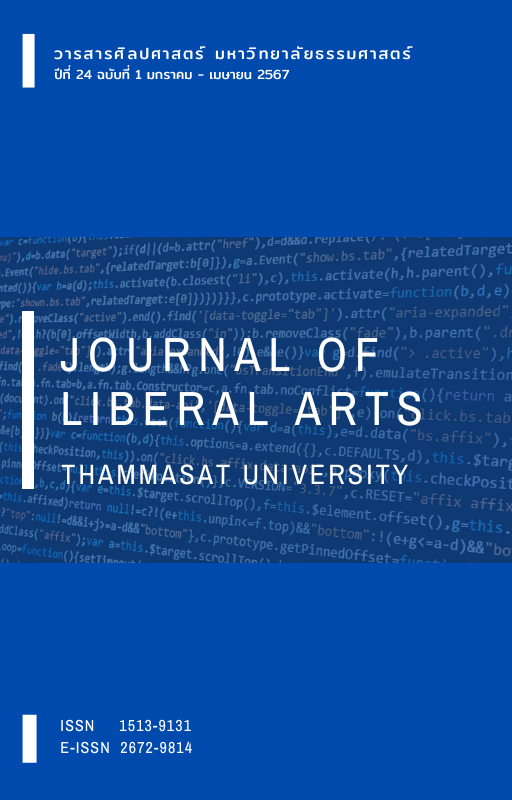An Analysis of Local Identities in Folktales of the Chinese Li Tribe
Main Article Content
Abstract
This qualitative research aims to analyze local identities in folktales of the Li Tribe in China. 199 stories of Li Tribe folktales, published and distributed in China, are selected to study. Six aspects of identities are found as follows. 1) Ways of life: residences of the Li people have been built from natural materials on Hainan Island, for example, a boat cabin or dwellings in caves on the Li-mu Hill; professions of Li people also relating to nature, such as farming of Shan-lan rice, hunting and foraging on the Five Fingers Hill, planting coconut trees; and the traditional dress code, for example a male turban, wearing a necklace or mane for females. 2) Tradition: relating to living and ancestral beliefs, for example, females wearing tattoos; greeting guests with Shan-lan liquor; eating betel nuts on the 3rd of March; distributing food and singing for marriage proposals. 3) Music and dancing: Li people invented some music instruments from natural materials, such as Li-le and Ding-dong; local dancing of the Li includes foot dancing with bamboo posts, and dancing with hawker baskets of coins, for example. 4) Use of herbs: Li people use herbs on Hainan Island in many ways, such as using the bark of Bombax ceiba for wound healing, using herbs for trapping animals, drinking coconut juice for internal body healing, and using Agarwood. 5) The matriarchal role: senior women of the Li Tribe would preside in the ritual of tattooing. 6) Wisdom: how to farm Shan-lan rice is the distinguishing inherited wisdom of the present Li people.
Downloads
Article Details

This work is licensed under a Creative Commons Attribution-NonCommercial-NoDerivatives 4.0 International License.
References
ณัฐพงศ์ รักงาม. (2559). แนวคิดอัตลักษณ์ท้องถิ่นภายใต้บริบทการเปลี่ยนแปลงในยุคโลกาภิวัตน์. วารสารวิทยาลัยสงฆ์นครลำปาง, 5(2), 1-14.
พงษ์ศักดิ์ คนขยัน. (2552). การศึกษาอัตลักษณ์ที่ปรากฏในนิทานไทใหญ่ อำเภอแม่อาย จังหวัดเชียงใหม่ [การค้นคว้าแบบอิสระปริญญามหาบัณฑิต]. มหาวิทยาลัยเชียงใหม่.
เมชฌ สอดส่องกฤษ. (2554). ชนกลุ่มน้อยในประเทศสาธารณรัฐประชาชนจีนและสถานภาพการศึกษาในประเทศไทย. วารสารศิลปศาสตร์ มหาวิทยาลัยอุบลราชธานี, 7(2), 46.
เมชฌ สอดส่องกฤษ. (2559). นานาภาษาในประเทศจีนตอนใต้ 2: ภาษาตระกูลไท เล่ม 1 (พิมพ์ครั้งที่ 1). โรงพิมพ์มหาวิทยาลัยอุบลราชธานี.
ลภัสรินทร์ ฉัตรวังคีรี. (2563). อัตลักษณ์พื้นถิ่นในบันเทิงคดีล้านนา (พ.ศ.2521-2554) (พิมพ์ครั้งที่ 2). สำนักพิมพ์มหาวิทยาลัยเชียงใหม่.
เสมอชัย พูลสุวรรณ. (2542). คนไทและเครือญาติในมณฑลไหหลำและกุ้ยโจวประเทศสาธารรัฐประชาชนจีน (พิมพ์ครั้งที่ 1). โรงพิมพ์มหาวิทยาลัยธรรมศาสตร์.
อุทุมพร ศรีโยม. (2565). การพัฒนาตราสินค้า และบรรจุภัณฑ์สำหรับข้าวพันธุ์พื้นเมืองสะท้อนอัตลักษณ์ท้องถิ่นบ้านโคกสูง จังหวัดนครศรีธรรมราช. วารสารรัชต์ภาคย์, 16(45), 66-82.
Chen, H. (2003). Effects of Litchi Age and Winter Temperature on Flowering Habits in Southern Florida. World Tropical Agriculture Information, 2003(8), 25.
Chen, Z., Ni, G., & Zhou, H. (2018). The History, value, conservation and utilization of the Shanlan rice in Li ethnic regions of Hainan province. Journal of Guangxi University for Nationalities, 40(4), 82-87.
Cheng, L. (2014). Unique Li Nationality Wine Culture. Baikezhishi, 1(15), 55-56.
Feng, F. (2014). Chemical constituents from the barks of Bombax malabaricum. Lishizhen Medicine and Mate Ria Medical Research, 25(12), 2826-2827.
Feng, J. (2020). The dissemination and recreation of Li folk tales in animated films. Journal of News Research, 11(5), 18.
Fu, C. (2011). The Symbolic meaning of Li People’s Tattoo. Journal of Qiongzhou University, 18(6), 16-20.
Fu, Z. & Su, H. (1982). Li people folklore. Huacheng Press.
Gong, L. (2017). A study of Hainan Folk festivals: A case study of Li people and the Miao mationality in March 3. Xijuzhijia, 1(2), 258-259.
Gong, T., & Li, Z. (2022). Simple practical wisdom: A study on the construction techniques of the floor boat-shaped house of the Li ethnic group in Hainan. ZHUANGSHI Folk Art and Culture, 354(10), 88-93.
He, H. (2023). Study on bamboo and wood musical instruments of Li under the cultural integration. The Journal of South China Sea Studies, 9(2), 111-118.
Huang, X. (2019). Study of the legends of the Li people in Hainan [Doctoral dissertation]. Minzu University of China.
Li, D., & Guo, L. (2023). Hainan agarwood: A hundred Billion-Yuan industry on the rise (1st ed.). Jingjicankaobao Press.
Liang, L. (2016). Ethnobotantical study on wild vegetable resources of Li minority in Wuzhishan region of Hainan. Journal of Qiongzhou University, 23(2), 60-65.
Long, M., & Huang, S. (2002). Li people folklore. Nanhai Press.
Luo, W. (2019). Research on the inheritance and protection of traditional brocade craft of Li nationality [Doctoral dissertation]. South-Central University for Nationalities.
Ma, Q., & Du, L. (2020). A study on the influence of Li folk tales on the development of folk culture in Hainan. Social fabric, 1(3), 172.
Muramaru, N. (2020). Japanese Folk Tales (1st ed.). Sripanya.
Shan, W. (2022). The predicament and countermeasures of the inheritance and development of marriage custom culture in Li people under the rural revitalization strategy -- Take the Li nationality’s “March 3” as an example. The Fusion of Literature and Travel, 1(25), 139-141.
Wang, W. (2009). The fifth of the intangible cultural heritage bamboo instruments, the colorful Hainan Li people bamboo instrument - Li Le. Yueqi, 2009(9), 70-72.
Wang, X. (2018). The description and study of the Li people’s tattooing by foreign and Chinese personages during the republic of China. Journal of Hainan Normal University, 4(31), 124-131.
Wu, M. (2003). Classification and introduction of Li people dance. Journal of Qiongzhou University, 10(6), 59-63.
Xing, Z. (2012). Exploration on betelnut culture of GaoShanZu of Taiwan and Li minority of Hainan. Journal of Qingyuan Polytechnic, 5(1), 1-8.
Yang, D. (2013). Study on spatial morphology of traditional settlement and architecture in Hainan island [Doctoral dissertation]. South China University of Technology.
Yang, L. (2013). Hemu and reproduction of local society: The anthropological inspection of highland Li people in Hainan [Doctoral dissertation]. Shanghai University.
Yang, Y. (2013). Study on the toxicology of derris root dust, a botanical insecticide for controlling red imported fire ant. Guangdong Agricultural Sciences, 1(21), 91-107.
Yao, L. (2003). Brief talk on female folk cultures of Li nationality on Hainan island. Journal of the Central University for Nationalities, 6(30), 51-55.
Zhang, L. (2019). The construction of symbolic sign of Hainan in the context of new media: A case study on the symbol of coconut in the new media of Hainan daily and Baidu news [Master’s thesis]. Hainan University.


